CADILLAC FLEETWOOD 1994 Owners Manual
Manufacturer: CADILLAC, Model Year: 1994, Model line: FLEETWOOD, Model: CADILLAC FLEETWOOD 1994Pages: 398, PDF Size: 19.19 MB
Page 311 of 398
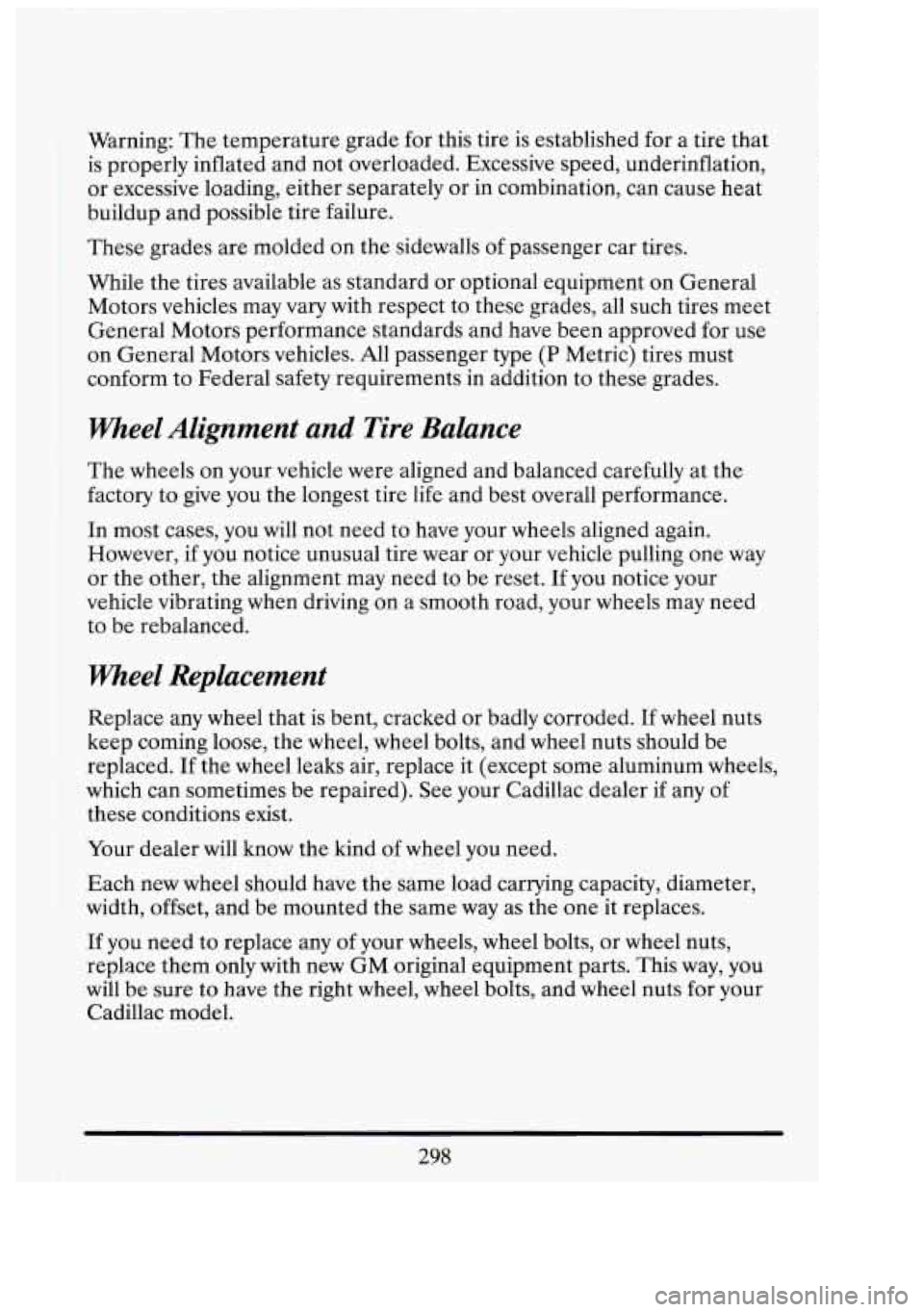
Warning: The temperature grade for this tire is established for a tire that
is properly inflated and not overloaded. Excessive speed, underinflation,
or excessive loading, either separately or in combination, can cause heat
These grades are molded on the sidewalls of passenger car tires.
I buildup and possible tire failure.
While the tires available as standard or optional equipment on General
Motors vehicles may vary with respect to these grades, all such tires meet
General Motors performance standards and have been approved for use
on General Motors vehicles.
All passenger type (P Metric) tires must
conform to Federal safety requirements in addition to these grades.
Wheel Alignment and Tire Balance
I
The wheels on your vehicle were aligned and balanced carefully at the
factory to give you the longest tire life and best overall performance.
In most cases, you will not need to have your wheels aligned again.
However, if you notice unusual tire wear or your vehicle pulling one way
or the other, the alignment may need to be reset. If
you notice your
vehicle vibrating when driving on a smooth road, your wheels may need
to be rebalanced.
Wheel Rephcement
Replace any wheel that is bent, cracked or badly corroded. If wheel nuts
keep coming loose, the wheel, wheel bolts, and wheel nuts should be
replaced.
If the wheel leaks air, replace it (except some aluminum wheels,
I which can sometimes be repaired). See your Cadillac dealer if any of
these conditions exist.
Your dealer will know the kind
of wheel you need.
Each new wheel should have the same load carrying capacity, diameter,
width, offset, and be mounted the same way as the one it replaces.
If you need to replace any of your wheels, wheel bolts, or wheel nuts,
replace them only with new GM original equipment parts. This way, you
will be sure to have the right wheel, wheel bolts, and wheel
nuts for your
Cadillac model.
I
ni
298
-
Page 312 of 398
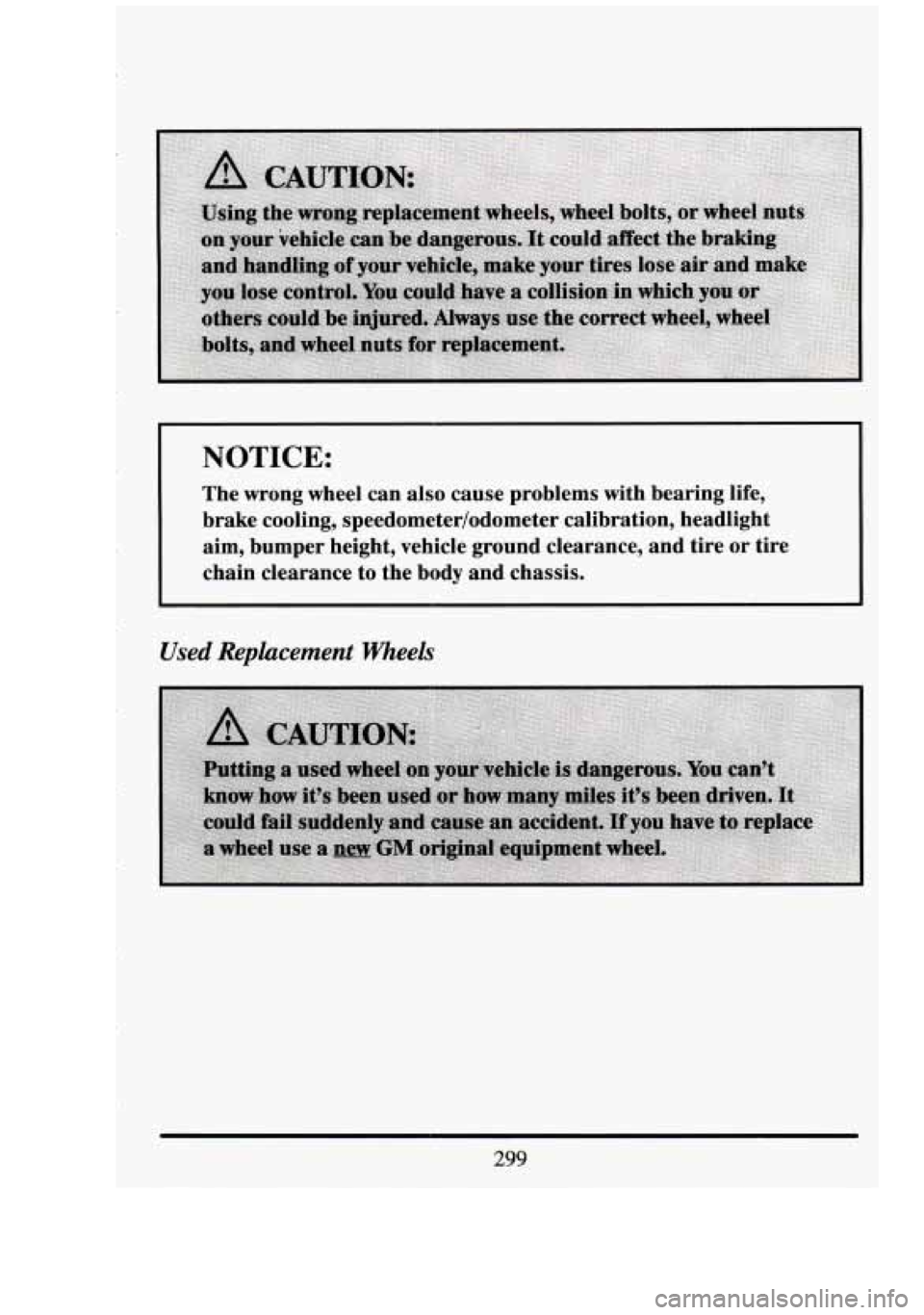
NOTICE:
The wrong wheel can also cause problems with bearing life,
brake cooling, speedometer/odometer calibration, headlight
aim, bumper height, vehicle ground clearance, and tire or tire \
chain clearance to the body and chassis.
Used Replacement Wheels
299
Page 313 of 398
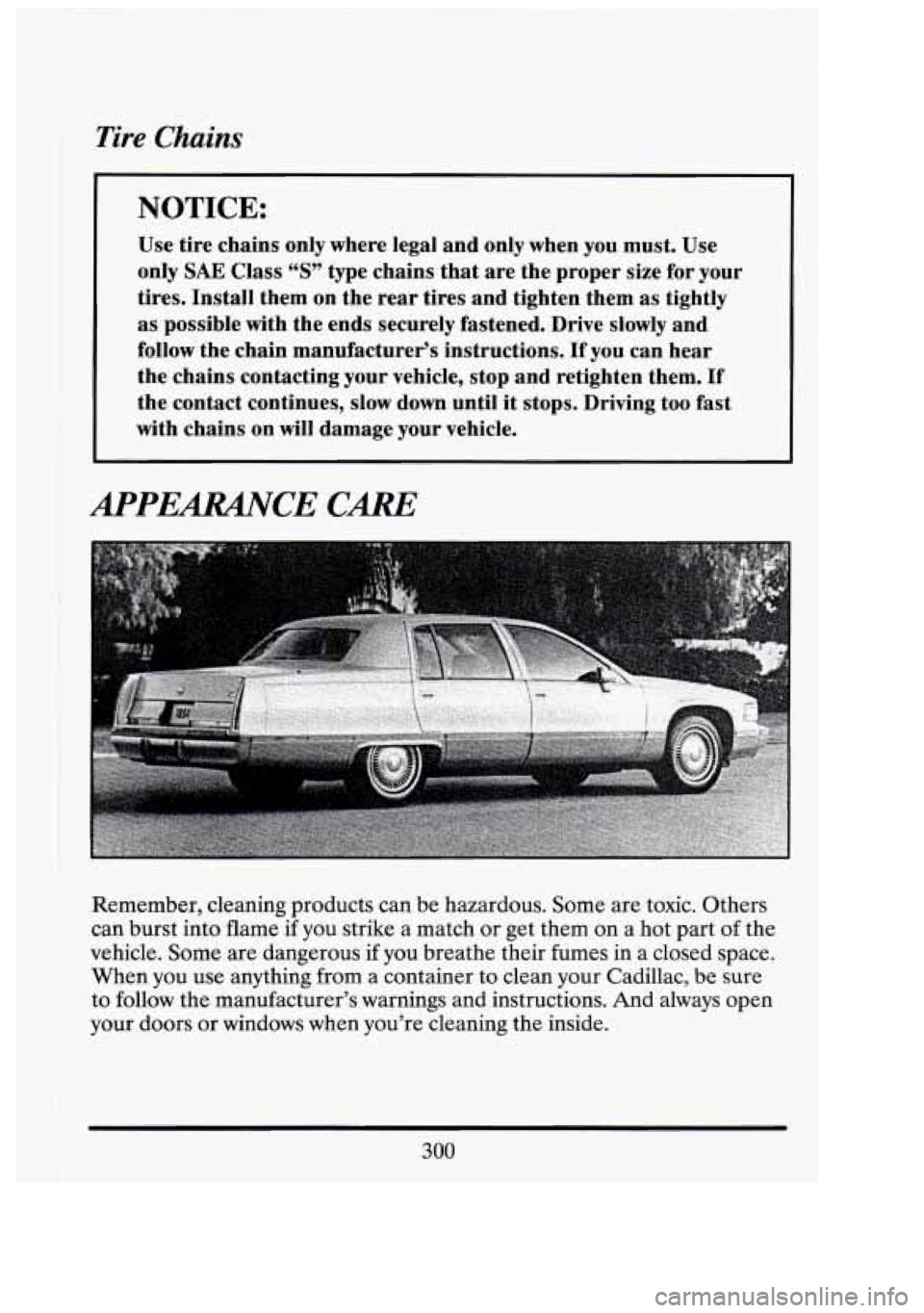
Tire Chains
NOTICE:
Use tire chains only where legal and only when you must. Use
only
SAE Class “S” type chains that are the proper size for your
tires. Install them
on the rear tires and tighten them as tightly
as possible with the ends securely fastened. Drive slowly and
follow the chain manufacturer‘s instructions.
If you can hear
the chains contacting your vehicle, stop and retighten them. If
the contact continues, slow down until it stops. Driving too fast
with chains on
will damage your vehicle.
APPEARANCE CARE
Remember, cleaning products can be hazardous. Some are toxic. Others
can burst into flame if
you strike a match or get them on a hot part of the
vehicle. Some are dangerous
if you breathe their fumes in a closed space.
When you use anything from a container
to clean your Cadillac, be sure
to follow the manufacturer’s warnings and instructions. And always open
your doors or windows when you’re cleaning the inside.
300
-1
n
1
”I
li 11.11
3
Page 314 of 398
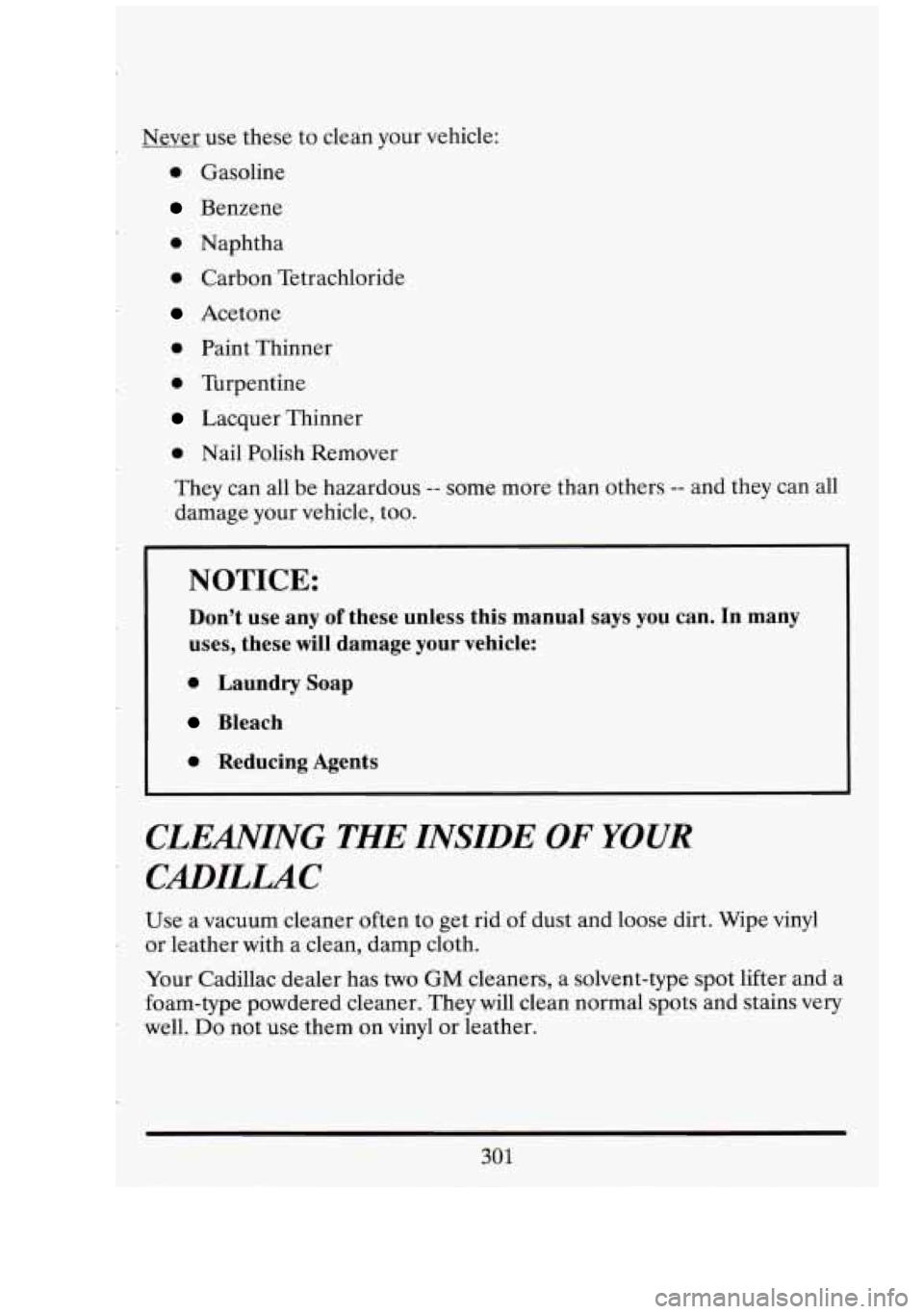
7
Never use these to clean your vehicle:
0 Gasoline
Benzene
0 Naphtha
0 Carbon Tetrachloride
Acetone
0 Paint Thinner
0 Turpentine
Lacquer Thinner
0 Nail Polish Remover
They can all be hazardous
-- some more than others -- and they can all
damage your vehicle, too.
NOTICE:
Don't use any of these unless this manual says you can. In many
uses, these will damage your vehicle:
Laundry Soap
Bleach
0 'Reducing Agents
CLEANIN% THE INSIDE OF YOUR
Use a vacuum cleaner often to get rid of dust and loose dirt. Wipe vinyl
or leather with a clean, damp cloth.
Your Cadillac dealer has
two GM cleaners, a solvent-type spot lifter and a
foam-type powdered cleaner. They will clean normal spots and stains
very
well. Do not use them on vinyl or leather.
301
Page 315 of 398
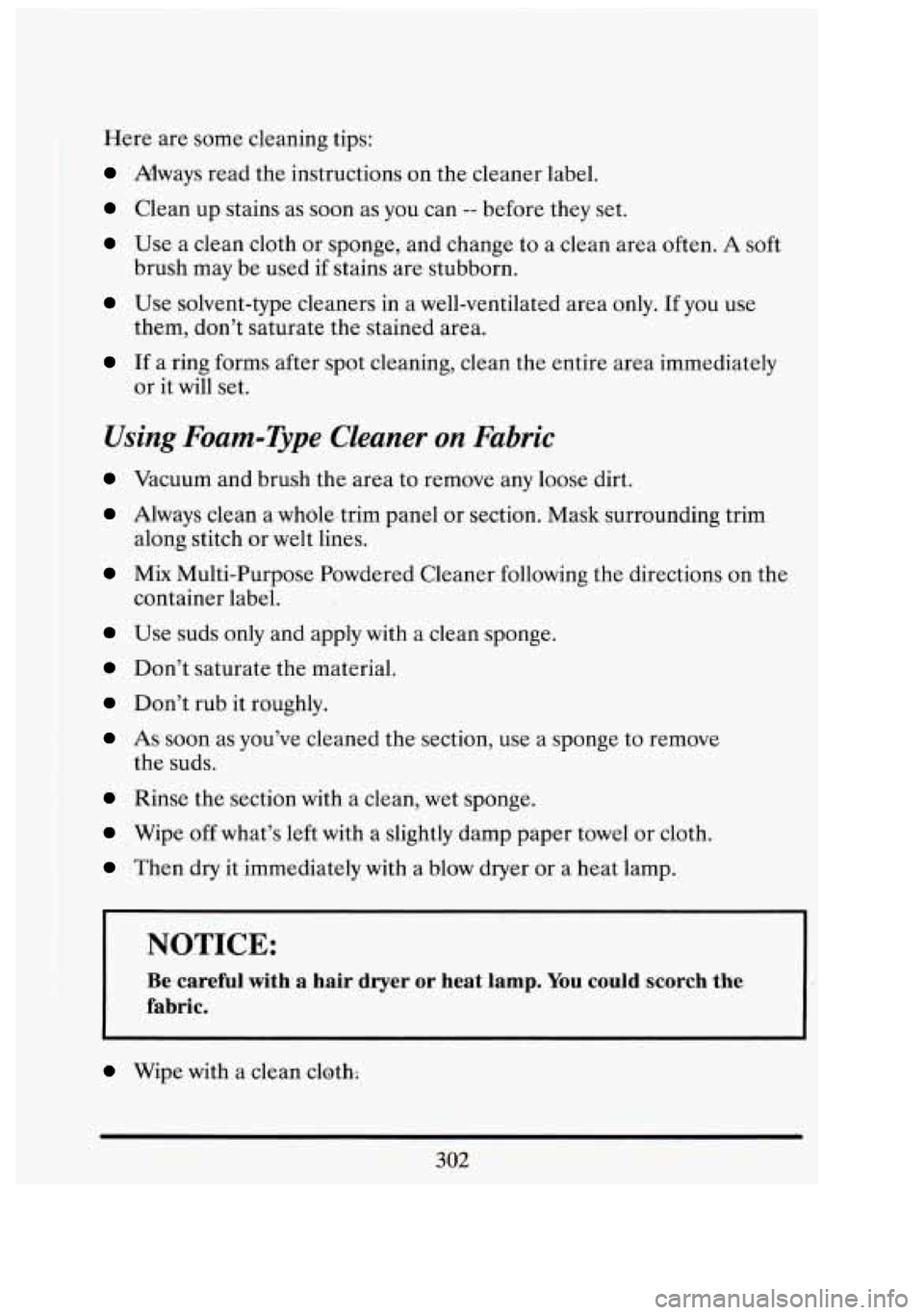
1
Here are some cleaning tips:
Always read the instructions on the cleaner label.
Clean up stains as soon as you can -- before they set.
Use a clean cloth or sponge, and change to a clean area often. A soft
Use solvent-type cleaners in a well-ventilatcd area only. If you use
brush
may be used if stains are stubborn.
them, don’t saturate .the stained area.
If a ring forms after spot cleaning, clean the entire area immediately
or it will set.
Using Foam-Type Cleaner on Fabric
Vacuum and brush the area to remove any loose dirt.
Always clean a whole,trim panel or section. Mask surrounding trim
Mix Multi-Purpose Powdered Cleaner following the directions on the
along
stitch or welt lines.
container label.
Use suds only and apply with a clean sponge.
Don’t saturate the material.
Don’t rub it roughly.
As soon as you’ve cleaned the section, use a sponge to remove
the suds.
Rinse the section with a clean, wet sponge.
Wipe off what’s left with a slightly damp paper towel or cloth.
Then dry it immediately with a blow dryer or a heat lamp.
NO.TICE:
Bexareful with.a hair dryer or heat lamp. You could scorch the
fabric.
Wipe with a clean,cloth:
nl
oi
r
c -1
& .i
302
Page 316 of 398
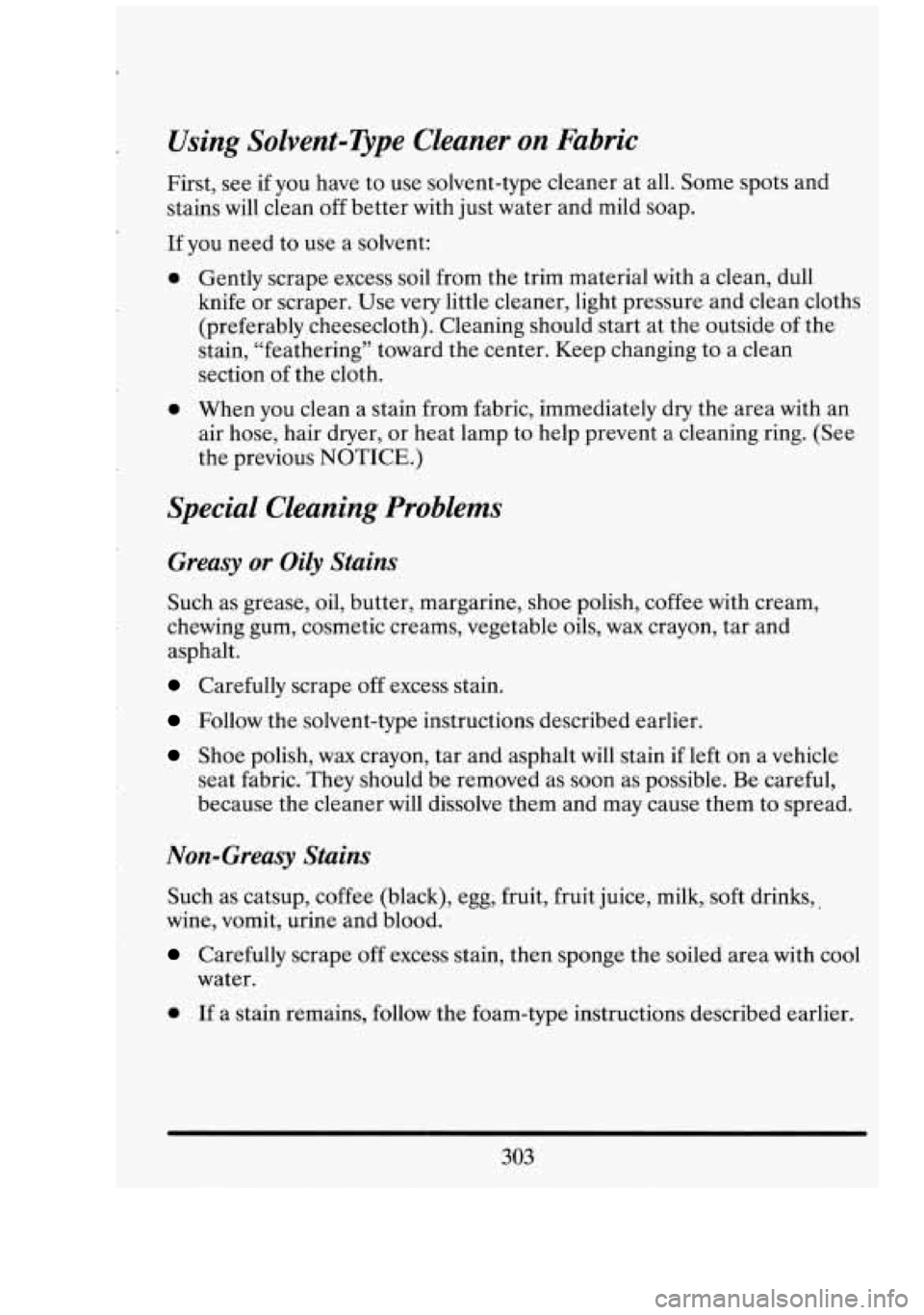
r_ Using Solvent-Type Cleaner on Fabric
First, see if you have to use solvent-type cleaner at all. Some spots and
stains
will clean off better with just water and mild soap.
If you need to use a solvent:
0 Gently scrape excess soil from the trim material with a clean, dull
knife or scraper. Use
very little cleaner, light pressure and clean cloths
(preferably cheesecloth). Cleaning should start at the outside of the
stain, “feathering” toward the center. Keep changing
to a clean
section of the cloth.
0 When you clean a stain from fabric, immediately dry the area with an
air hose, hair dryer, or heat lamp
to help prevent a cleaning ring. (See
the previous NOTICE.)
Special Cleaning Problems
Greasy or Oily Stains
Such as grease, oil, butter, margarine, shoe polish, coffee with cream,
chewing gum, cosmetic creams, vegetable oils,
wax crayon, tar and
asphalt.
Carefully scrape off excess stain.
Follow the solvent-type instructions described earlier.
Shoe polish, wax crayon, tar and asphalt will stain if left on a vehicle
seat fabric. They should be removed as soon as possible. Be careful,
because the cleaner will dissolve them and may cause them to spread.
Non-Greasy Stains
Such as catsup, coffee (black), egg; fruit, fruit juice, milk, soft drinks,.
wine, vomit, urine and blood.
Carefully scrape off excess stain, then sponge the soiled area with cool
water.
0 If a stain remains, follow the foam-type instructions described earlier.
303
Page 317 of 398
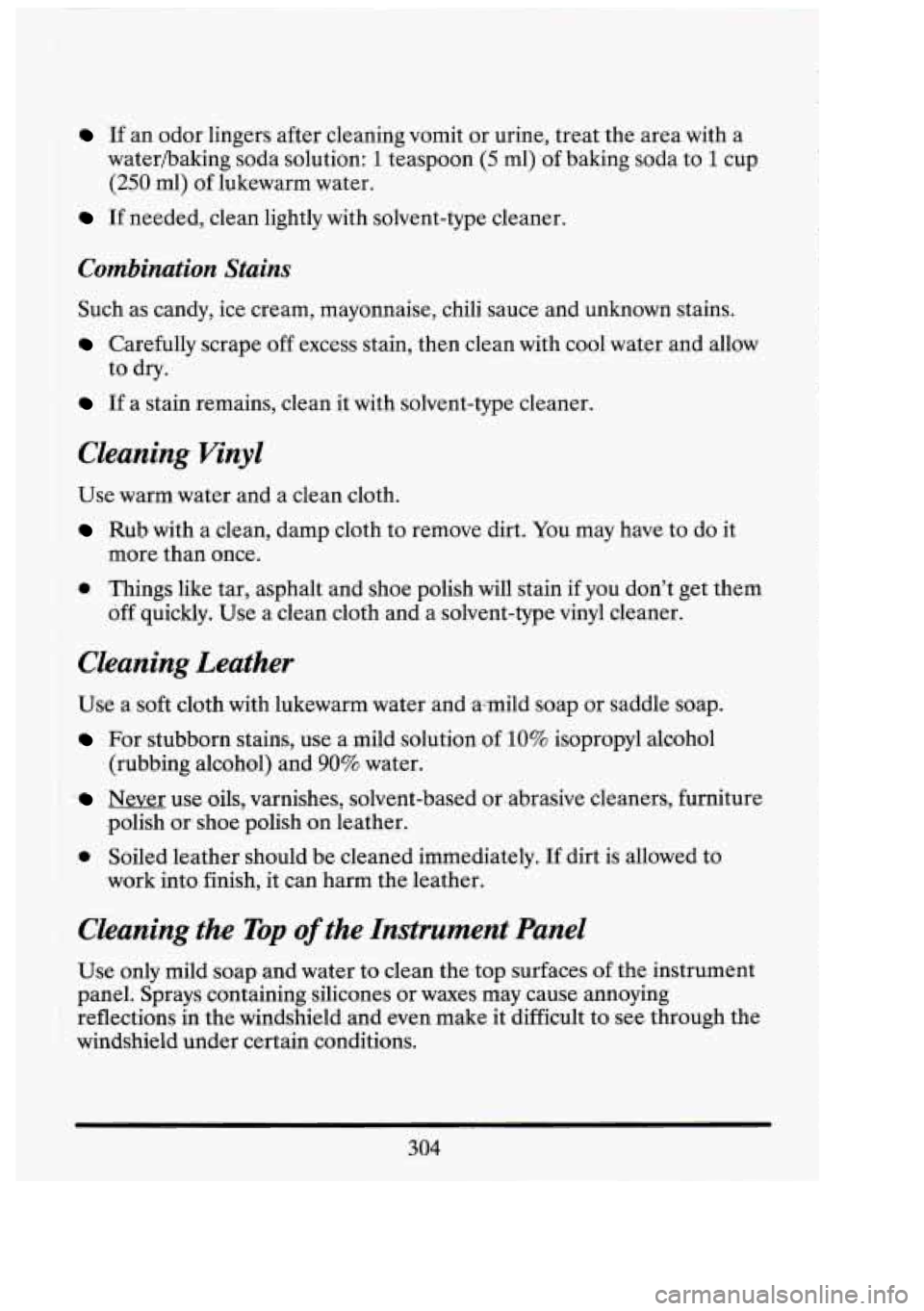
If an odor lingers after cleaning vomit or urine, -treat the area with a
waterbaking soda solution:
1 teaspoon (5 ml) of baking soda to 1 cup
(250 ml) of lukewarm water.
If needed, clean lightly with solvent-type cleaner.
I Combination Stains
I Such as candy, ice cream, mayonnaise, chili sauce and unknown stains.
I
Carefully scrape off excess stain, then clean with cool water and allow
If a stain remains, clean it with solvent-type cleaner.
to
dry.
Use
warm water and a clean cloth.
Rub with a clean, damp cloth to remove dirt. You may have to do it
more than once.
Things like tar,.asphalt and shoe polish will stain
if you don't get them
off quickly. Use a clean clofh and a solvent-type vinyl cleaner.
Cleaning Leather
Use a soft cloth-with lukewarm water and,amild soap or saddle soap.
For stubborn stains, use a mild solution .of 10% isopropyl alcohol
Never use oils, varnishe.s, solvent-based or tabrasive cleaners, furniture
.a Soiled leather should be cleaned immediately. If dirt is allowed to
I (rubbing alcohol) and 90% water.
polish or' shoe polish on leather.
work into finish, it can harm the leather.
Cleaning the Top of the Instrument Panel
Use only mild soap and water to clean the .top surfaces of the instrument
panel. Sprays containing silicones or waxes may .cause annoying
reflections
in the windshield and even make it difficult to see through the
-windshield under certain conditions.
304
31
i
I I
a'
ni
-1
Lj j
Page 318 of 398
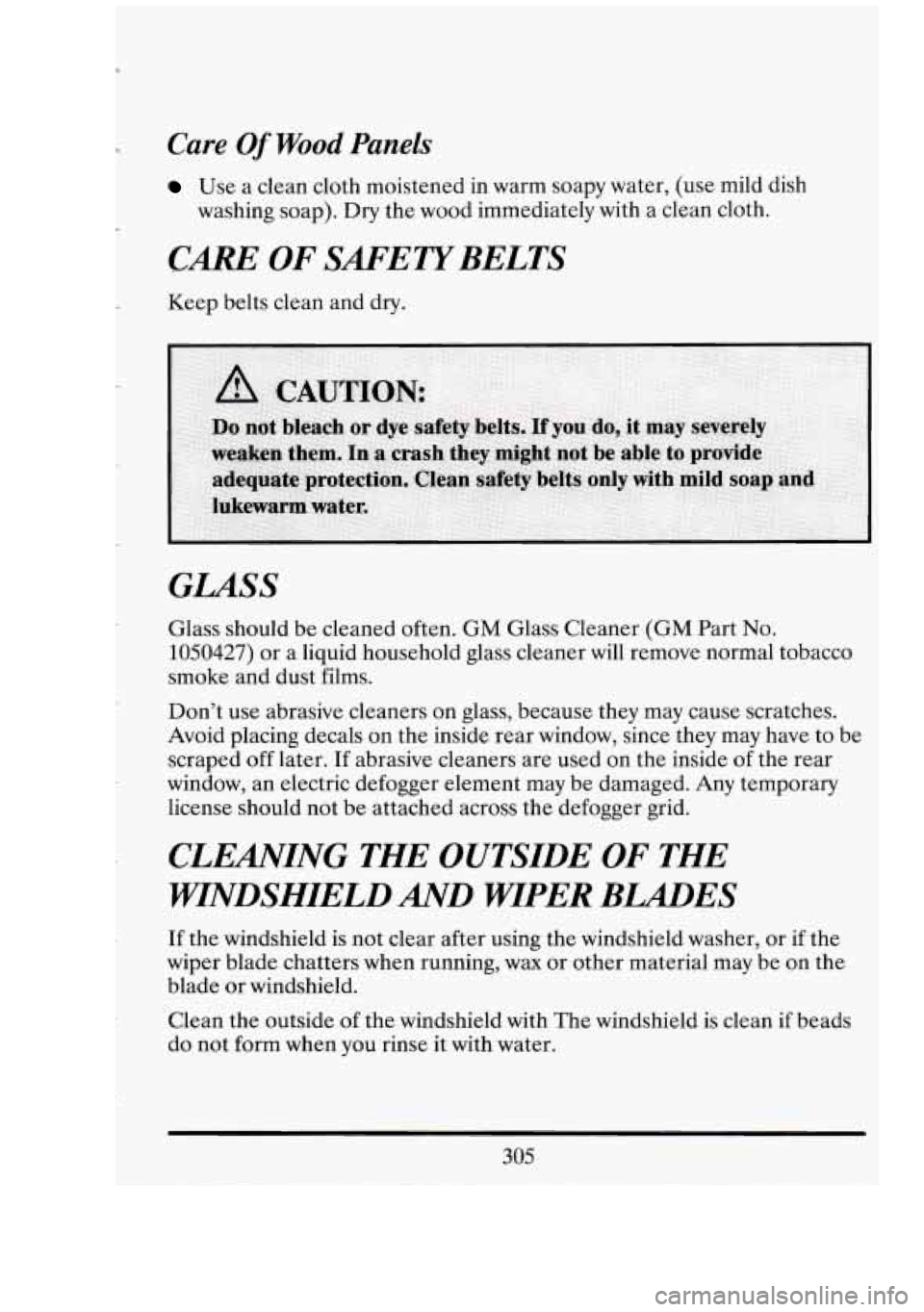
r Care Of Wood Panels
Use a clean cloth moistened in warm soapy water, (use mild dish
washing soap). Dry the wood immediately with a clean cloth.
CARE OF SAFETYBELTS
Keep belts clean and dry.
GLASS
Glass should be cleaned often. GM Glass Cleaner (GM Part No.
1050427) or a liquid household glass cleaner will remove normal tobacco
smoke and dust films.
Don’t use abrasive cleaners on glass, because they may cause scratches.
Avoid placing decals on the inside rear window, since they may have to be
scraped
off later. If abrasive cleaners are used on the inside of the rear
window, an electric defogger element may be damaged. Any temporary
license should not be attached across the defogger grid.
CLEANIING THE OUTSIDE OF THE
WINDSHIELD AND WIPER BLADES
If the windshield is not clear after using the windshield washer, or if the
wiper blade chatters when running,
wax or other material may be on the
blade or windshield.
Clean the outside of the windshield with The windshield
is clean if beads
do not form when
you rinse it with water.
305
Page 319 of 398
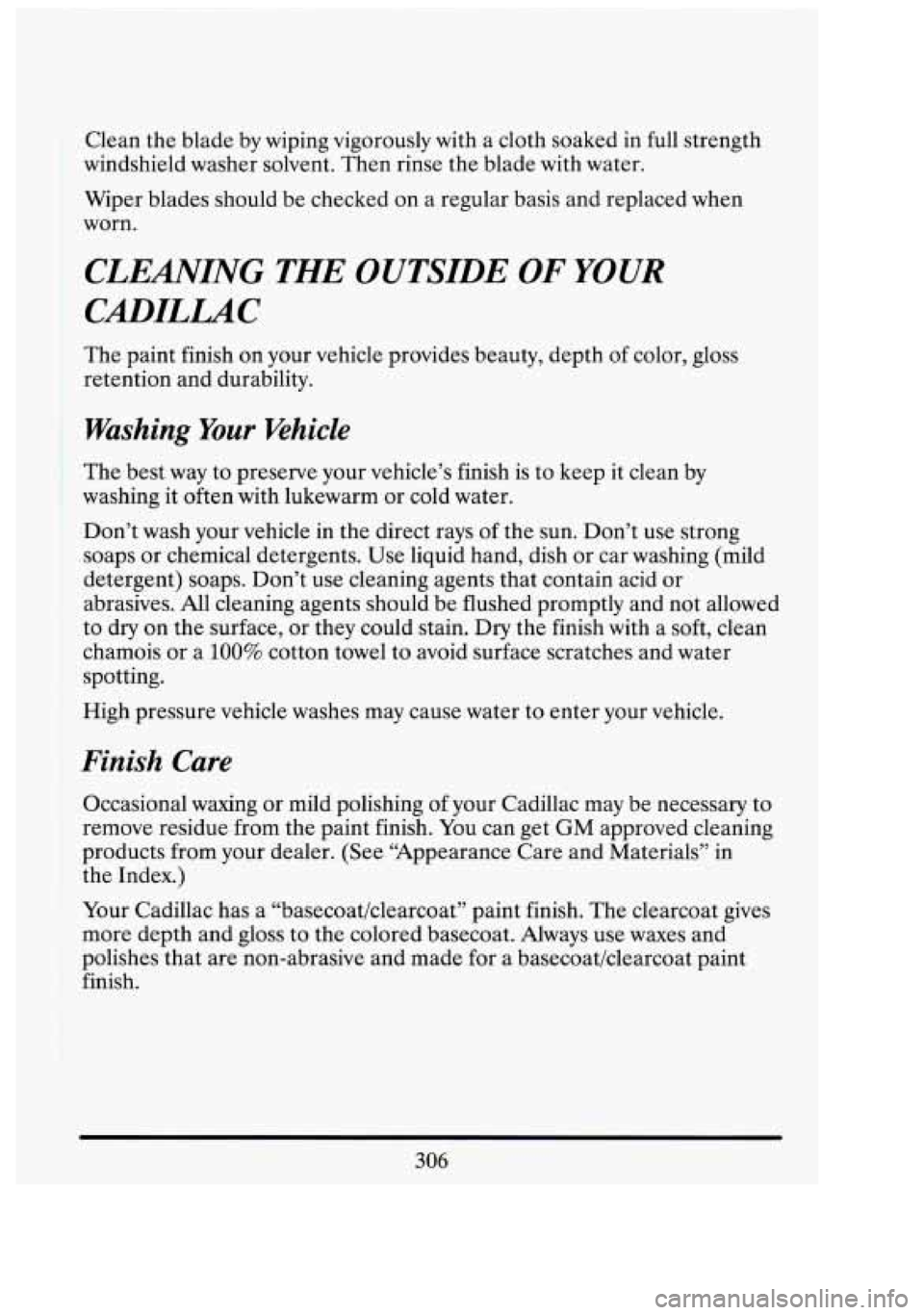
Clean the blade by wiping vigorously with a cloth soaked in full strength
windshield washer solvent. Then rinse the blade with water.
Wiper blades should be checked on a regular basis and replaced when
worn.
CLEANING THE OUTSIDE OF YOUR
CrnILUC
The paint finish on your vehicle provides beauty, depth of color, gloss
retention and durability.
Washing Your Whicle
The best way to preserve your vehicle’s finish is to keep it clean by
washing it often with lukewarm or cold water.
Don’t wash your vehicle in the direct rays of the sun. Don’t use strong
soaps or chemical detergents. Use liquid hand, dish or car washing (mild
detergent) soaps. Don’t use cleaning agents that contain acid or
abrasives. All cleaning agents should be flushed promptly and not allowed
to dry on the surface, or they could stain. Dry the finish
with a soft, clean
chamois
or a 100% cotton towel to avoid surface scratches and water
spotting.
High pressure vehicle washes may cause water to enter your vehicle.
Finish Care
Occasional waxing or mild polishing of your Cadillac may be necessary to
remove residue from the paint finish. You can get
GM approved cleaning
products from your dealer. (See “Appearance Care and Materials” in
the Index.)
Your Cadillac has a “basecoat/clearcoat” paint finish. The clearcoat gives
more depth and gloss to the colored basecoat. Always use waxes and
polishes that are non-abrasive and made for a basecoat/clearcoat paint
finish.
306
Page 320 of 398
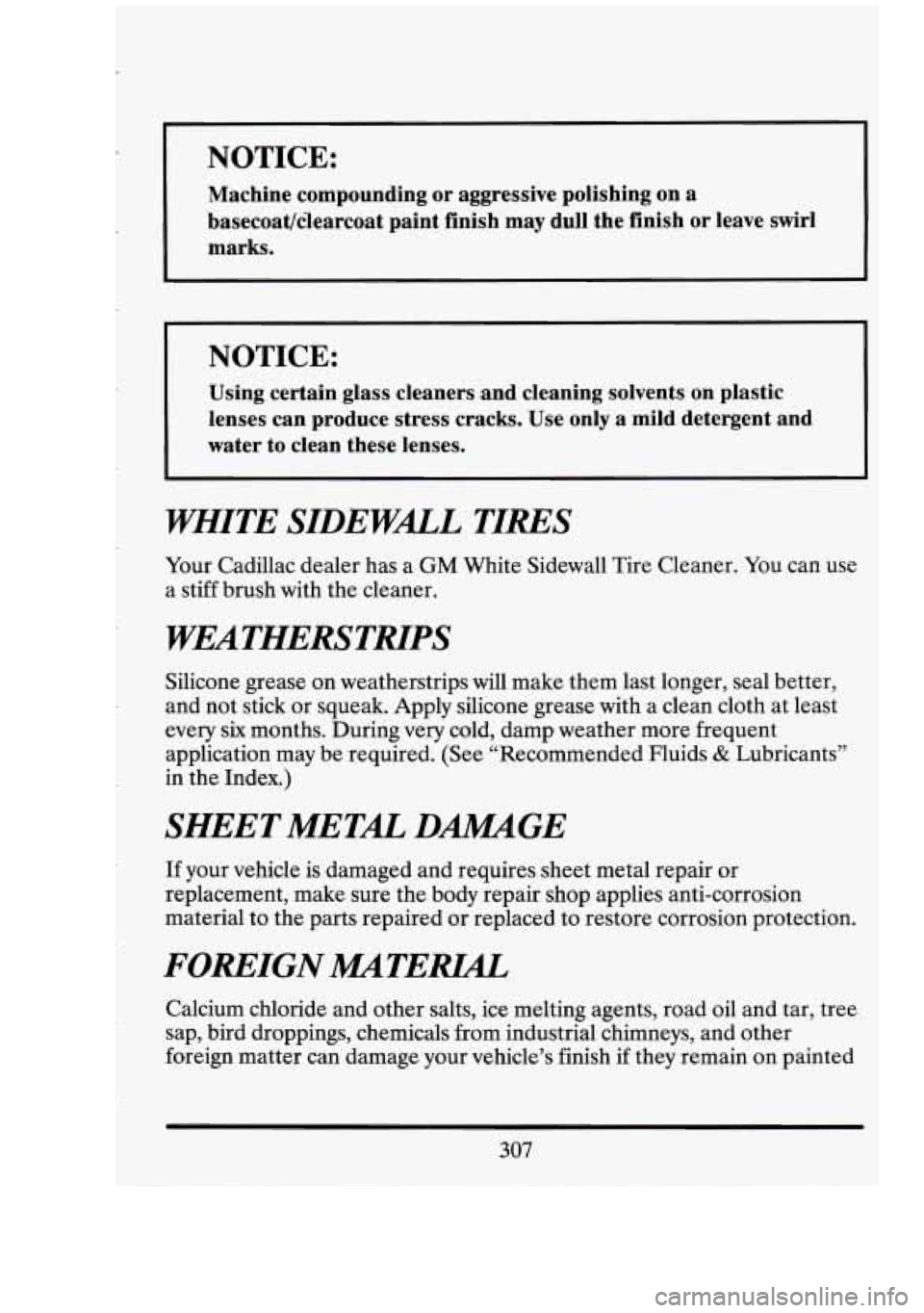
I NOTICE: I
Machine compounding or aggressive polishing on a
basecoat/clearcoat paint finish may dull the finish or leave swirl
marks.
NOTICE:
Using certain glass cleaners ,and cleaning solvents on plastic
lenses can produce stress cracks. Use only a mild detergent and
water to clean these lenses.
WHITE SIDEWALL TIRES
Your Cadillac dealer has a GM White Sidewall Tire Cleaner. You can use
a stiff brush with the cleaner.
WEATHERSTRIPS
Silicone grease on weatherstrips will make them last longer, seal better,
and not stick or squeak. Apply silicone grease with a clean cloth at least
every six months. During very cold, damp weather more frequent
application may be required. (See “Recommended Fluids
& Lubricants”
in the Index.)
SHEETMETAL DMGE
If your vehicle is damaged and requires sheet metal repair or
replacement, make sure the body repair shop applies anti-corrosion
material to the parts repaired or replaced to restore corrosion protection.
FOREIGN MATERLAL,
Calcium chloride and other salts, ice melting agents, road oil and tar, tree
sap, bird droppings, chemicals from industrial chimneys, and other
foreign matter can damage your vehicle’s finish if they remain on painted
307